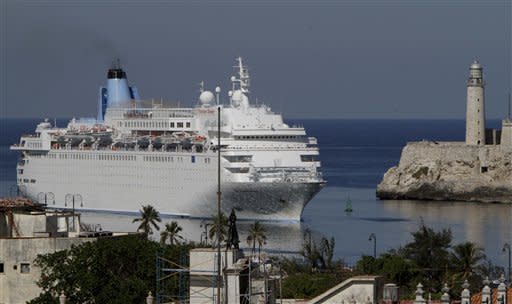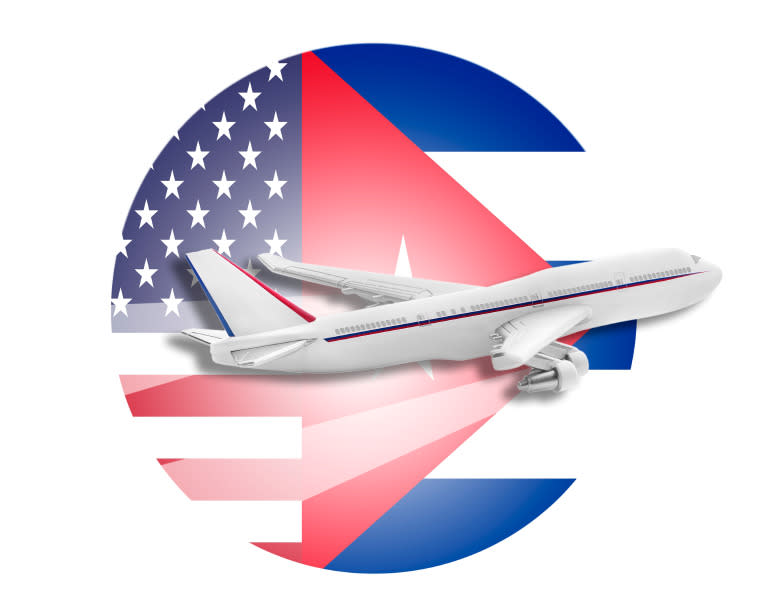The Americans Are Coming! Is Cuba Ready?

How is American tourism going to change Cuba? (Illustration: iStock)
Cuba is on the verge of a U.S. invasion — not by a conquering army but by a wave of American tourists, the travel industry, and numerous companies all poised to make it the next big vacation spot for American tourists. But for the tiny Caribbean island, that’s a classic case of “Buena noticia, mala noticia.”
First, the good news. Ever since the Obama administration restored diplomatic ties with Cuba earlier this year and loosened some (but not all) travel restrictions, tourism to the Caribbean island has skyrocketed. Reuters reports more Americans visited Cuba — 106,000, to be exact — by the third quarter of this year than all of last year. In fact, with more than 3 million total foreign visitors in 2014, Cuba is the second most popular destination in the Caribbean, behind the Dominican Republic.
“Cuba is hot,” Michael Holtz, CEO of luxury travel agency SmartFlyer, tells Yahoo Travel. “Not a week goes by in our New York office without someone booking a trip to Cuba or asking about Cuba. People want to go see what’s going on there.”

With travel restrictions loosened, more Americans are visiting Cuba. (Photo: AP)
Even more remarkable: The current boom is taking place while the U.S. still bans most travel to Cuba. Technically, the island is forbidden to U.S. visitors unless they fall into one of 12 authorized categories, including family visits and journalistic, religious, professional, and humanitarian activities. The only way many Americans can get to Cuba legally is via supervised group trips and chartered flights (of course, they could also travel to Cuba illegally via a third country with no travel ban).
Related: Cuba Looks for Edge Over Caribbean Rivals With Study of U.S. Tourists
So if Cuba is popping now, imagine what will happen once the U.S. travel ban is further loosened or lifted entirely, as many experts feel is inevitable if not imminent. Once free-spending Americans can travel to Cuba limited only by their work schedules and travel budgets, how long before Cuba becomes the number one vacation destination in the Caribbean?
“Probably a week after the ban’s lifted,” says Tom Spagnola, senior vice president of supplier relations at booking site CheapOair. “The fascination of being able to go somewhere that Americans have not been able to travel — the demand is going to be unbelievable.”

A Cuba-appropriate cocktail: An American tourist drinks a daiquiri in front of a bronze statue of Ernest Hemingway at the Floridita Bar in Havana. (Photo: AP)
With Cuba already doing gangbusters among international travelers, the prospect of adding a million or so free-spending Americans to the mix has the entire travel industry intoxicated, and not on mojitos. “We’ve got big plans for Cuba,” an excited Scott Laurence, JetBlue Airways’ senior vice president of airline planning, tells Yahoo Travel.
Cruise companies feel the same way. “We feel very uniquely and strategically positioned for long-term relationships with Cuba,” says Tara Russell, president of Carnival Corporation’s new brand, Fathom, an “impact”-themed cruise line that takes passengers to developing nations to spend their vacations volunteering. The line hopes to start sailing to Cuba next year.
But that brings us to the bad news. With much of Cuba’s travel infrastructure unchanged from the way it was when the U.S. trade embargo went into effect in the 1960s, some travel experts are wondering how Cuba will accommodate the extra travelers who could come knocking once the U.S. allows unfettered travel to Cuba.

Will Havana’s ’50s and ’60s infrastructure be able to handle the waves of tourists it’s going to get? (Photo: iStock)
“The answer is simple: They can’t,” says SmartFlyer’s Holtz. Adds CheapOair’s Spagnola: “Cuba will not be able to keep up with the demand. From an airport perspective, a ground transportation perspective, hotels, dining and resorts — everything is going to be an investment for Cuba to upgrade everything to handle the traffic.”
With Cuba poised to become the belle of the Caribbean travel ball, Yahoo Travel talked to some industry leaders and experts about how the island is preparing for the many future suitors who will likely be calling in the coming years.

A ship from Britain’s Thomson cruise line docks in Havana. Will U.S. cruise lines be far behind? (Photo: AP)
Cruising
Even though U.S.-based cruise lines don’t sail to Cuba, foreign-owned cruise lines — including Fred. Olsen and Thomson Cruises — are free to sail there. According to the Cuban Transportation Ministry, 37,519 cruisers visited Cuba last year, a tremendous jump from the 6,770 who visited just two years earlier.
Later this month, Italian-based cruise line MSC will begin sailing out of Havana aboard the MSC Opera. Because of popular demand, MSC recently announced it’s adding a second Havana-based ship, the MSC Armonia (because of the U.S. travel ban, most of the passengers will likely be Canadian or European).
“We are very pleased and encouraged by the feedback we’re receiving with the first ships we have positioned [in Cuba],” MSC Cruises CEO Gianni Onorato tells Yahoo Travel. “Cuba is really a destination that our customers are looking at. There is a lot of culture and a lot of very interesting places to see.”

MSC’s Opera will start sailing out of Havana in December. (Photo: MSC)
Once the U.S. travel ban is lifted, U.S.-based cruise lines would like nothing more than to launch an armada of superships to Cuba from Florida; New York; Galveston, Texas; and New Orleans. “I wish I had ships in the water today to be able to capitalize on that,” a wistful Tom McAlpin, CEO of the Miami-based Virgin Cruises, told Yahoo Travel earlier this summer. “I think Cuba is going to be great for the industry. It provides us some more sex appeal to the Caribbean.”
Unfortunately for McAlpin, Virgin Cruises doesn’t launch until 2020. By that time, its rival U.S.-based cruise lines plan to already be at the party. Norwegian Cruise Line is talking to the U.S. and Cuban governments about possibly beginning cruises to Cuba. Carnival Corporation’s new Fathom cruise line already has U.S. approval to begin its “voluntourism” sailings to Cuba in May 2016. Once it gets the go-ahead from Havana, Fathom will be the first U.S. cruise line to visit Cuba since the 1960s.
Related: Cruising for Charity: Carnival Launches New Cruise Line for ‘Voluntourists’
“I think the world, especially the North American world, is very eager and hungry to see how travel to Cuba will change, potentially dramatically, over the next few years,” Fathom president Tara Russell tells Yahoo Travel. “While we absolutely expect things to change and travel restrictions to ease, I believe it will take a bit of time just because some of those infrastructure challenges you might imagine.”
Those infrastructure challenges aren’t insignificant. While docks in Havana do accommodate cruise ships, they’re nowhere near large enough to handle the 3,000- and 4,000-passenger superships that routinely crisscross the Caribbean. MSC and Fathom plan to compensate for that by sailing to Cuba on smaller cruise ships: The Adonia, Fathom’s sole cruise ship, is about 590 feet long, while MSC’s Opera and Armonia are each about 900 feet long (in contrast, Royal Caribbean’s Anthem of the Seas, which just started service to the Bahamas, is 1,142 feet long).

Fathom’s smaller-size Adonia should have no trouble fitting in Cuba’s ports. (Photo: fathom)
Currently, cruise lines aren’t sweating the smaller ports. “We do think that for the time being we can increase with the number of ships instead of increasing with the size of ships,” says MSC’s Onorato.
When Cuba does need bigger ports, there is room to grow (Cuba is an island, after all). “There are what we believe are 11 ports of promise around the island,” says Russell. Once Fathom becomes the first brand of the world’s biggest cruise corporation to establish a beachhead in Cuba, Russell expects Carnival’s other lines — which include Princess, Holland America, and, of course, Carnival — to follow. “We absolutely believe and expect that our other brands will begin to call on Cuba when it’s appropriate and realistic,” she says. You can bet other cruise lines are charting the same course.

The airline industry is setting its sights on Cuba. (Illustration: Thinkstock)
Airlines
Right now, U.S. commercial airplanes can fly to Cuba only when they’re leased to charter companies, which arrange private group trips to Cuba in accordance with the strict U.S. travel rules. American Airlines and JetBlue recently have expanded their charter services; this month alone, American will add Los Angeles-to-Havana flights, while JetBlue adds another flight from New York’s John F. Kennedy airport. Both airlines also fly to Cuba from cities in Florida.
With U.S. and Cuban officials trying to work out a deal for U.S. carriers to begin scheduling standard commercial flights to Cuba, airlines are getting ready for takeoff. “We have a plan that includes more liberalization [of U.S. travel rules],” Scott Laurence from JetBlue tells Yahoo Travel. “And we have a plan that includes the travel ban going away.”
WATCH: New Cuba Travel Rules
If that happens, there’s one immediate benefit travelers likely will see: lower fares to Cuba. Airfare analysis site Hopper recently estimated that the cost of a flight from the U.S. to Cuba — typically about $500 for a charter flight out of Miami or $700 for a connecting flight via Cancun — would plummet to around $375 once the travel ban goes away. “You will absolutely see airfares go down as competition comes in and more capacity is added,” says Laurence.
When that ban gets liberalized, Laurence isn’t worried about capacity. For one, he points out that Cuba already is an international destination; it has 10 international airports.

Havana’s José Martí International Airport: old but still getting the job done. (Photo: AP)
“You walk around Havana’s airport and there are global airlines you see that are no different than what you’d see in Miami or Orlando’s airports,” he says. “Virgin Atlantic and Air France are flying there and carrying a lot of people. We’ve had no hiccups at all flying into Cuba.”
While he praises Cuba’s airports, Laurence says they could use some upgrades, including enhancements to gates and customs services. He has concerns about what’s going on outside the airports too. “We’re obviously looking very closely at what can potentially happen with investments in hotel infrastructure as well,” he says. “We can carry a lot of customers, but they need somewhere to stay.”

Cuba’s Hotel Nacional. The island might need a few more of these to accommodate the next wave of American travelers. (Photo: iStock)
Hotels
Cuba appears keenly aware that it’s going to need more hotel space. Cuban tourism officials say the nation already has 63,000 rooms, with plans to build that number to 85,000 in five years. Then there’s Airbnb, which started offering Cuban homes last April with 1,000 listings. Within two months, that number had doubled — and it continues to rise.
Still, though, travel experts say that’s just not going to cut it. “There are not enough high-end hotel rooms to handle the market,” says SmartFlyer’s Holtz.
Fortunately for Cuba, this is another area where its current status as a big international destination — for countries other than the U.S. — gives it a leg up.
“Cuba has a very mature hotel environment,” Scott Berman, the leader of the U.S. hospitality and leisure practice at PricewaterhouseCoopers, tells Yahoo Travel. He cites Cuba’s inventory of European-run all-inclusive beachfront resorts that currently cater to travelers out of Europe, Canada, and Latin America. He says Cuba has another advantage: its pricing. “It’s relatively cheap to go to Cuba,“ he says.
Nevertheless, Berman also thinks Cuba is going to have to up its hotel game if it’s going to appeal to American travelers and compete with other locations like the Bahamas or Puerto Rico. “When it comes to those hotels that exist [in Cuba], it’s a quality issue,” he says. “You’re not going to find the majority of rooms are four- or five-diamond. The word that keeps coming to mind is ‘basic’ — not a lot of frills.”
The U.S.-based hotel giants know that too. According to Reuters, executives from Marriott International (which just announced merger plans with Starwood Hotels & Resorts), Hilton Worldwide, and Carlson Hospitality Group (which runs the Radisson hotel chain) have held talks with Cuban officials in recent months. Right now, those U.S.-based companies can’t invest in Cuba. But they appear ready to swoop in once that changes.
In a statement to Yahoo Travel, Hilton said: “Our portfolio includes more than 4,500 hotels in 97 countries and territories, and we have more than 1,500 hotels in our development pipeline. We welcome further opportunities to continue our rapid growth and deliver a warm welcome and exceptional experiences to guests in even more parts of the world, including Cuba if an agreement is reached with the U.S.”

Cubans use the country’s first public Wi-Fi hotspot in Havana this past summer. (Photo: AP)
Money and technology
For many years, the U.S. government banned the use of U.S.-issued credit cards in Cuba. That rule has since been relaxed; Americans now are allowed to use credit and debit cards in Cuba. But with the travel ban still technically in place, most U.S.-based debit and credit card issuers won’t process purchases made in Cuba; as the Miami Herald explains, they’re afraid they might be held liable for any purchases made by an American traveling to Cuba illegally. Nevertheless, Florida-based Stonegate Bank recently announced a debit MasterCard that Americans can use in Cuba. It’s not good at Cuba’s ATMs, but that could change next year
Then there’s the technology. Internet access is still relatively rare in Cuba. According to Verge, roughly 5 percent of the country has Web access — which simply won’t do for American vacationers tethered to their email and social media.
Cuba’s state-run telecommunications service, ETECSA, has been adding Wi-Fi hot spots around the country this year. On the mobile front, Verizon just announced international roaming in Cuba as part of its Pay-As-You-Go International Plan, while Sprint now has a direct roaming agreement and a direct long-distance interconnection agreement with ETECSA.

Cuba’s old-school charm may soon be a thing of the past. (Photo: iStock)
A change is gonna come
So it seems Cuba has some sprucing up to do before the American guests arrive in the post-ban era. That era may come soon, but no one can tell for sure when exactly that will be or when Cuba will make the necessary changes. “The reality is things are going to continue and progress and open up in Cuba,” says Fathom’s Tara Russell. “I just don’t believe the pace of that is going to feel as fast as the world might think right now.”
But make no mistake: Once the American invasion comes, Cuba will not be turning Americans away. The country will adapt, rebuild, and refurnish — with, of course, the help of deep-pocketed American companies eager to tap Cuba’s huge potential. That could mean that, as Cuba grows to accommodate the new wave of tourists, it could fall victim to the dreaded A-word: Americanization.
Related: Travel to Cuba Now Before It Becomes a Tourist Trap — Here’s How
“With the American dollar and the investment that a lot of these large companies will make, I think you’ll start to see your Starbucks, fast food restaurants, and department stores,” says CheapOair’s Spagnola.
“Once it gets commercialized, it’s going to be a different place,” agrees SmartFlyer’s Holtz. “But Cuba needs to get commercialized to handle the volume of people that want to come.”
Therein lies the ultimate irony. The very thing that will draw people to Cuba — the authentic, unspoiled charm of a land relatively untouched by Western over-commercialization — could actually end up being trampled by all the people attracted by that very virtue. And that could be the very thing that causes Cuba’s travel boom to subside.
“When you have a Ritz-Carlton in Havana and three hotels that are part of the leading hotels [groups], and Starbucks and McDonald’s and popular European chains coming in, then Cuba’s going to lose that mystique,” says Holtz. “And when the old Studebakers are gone and Mandarin Oriental hotels open and they’ve got a fleet of Rolls-Royces and Bentleys, I think fewer people are going to want to go to Cuba.”
Perhaps that’s a function of our ever-changing world. In just a generation, a place that was once an American-unfriendly Cold War trouble spot becomes an American-friendly Carnival Cruise tourist spot. “If you go back 20 years, how many Americans were going to Vietnam?” asks Holtz. “Not very many. Well, guess what: All the major brands are there now.”
As went Vietnam before it, so might Cuba go. “My guess is, in 2025, Cuba is going to be much less unique than it is now,” Holtz predicts. By that time, we may have moved on to developing another now-unlikely tourist destination. Says Holtz: “People may be going to Afghanistan on vacation,” Somewhere, some forward-thinking airline or hotel exec likely is planning for that very contingency.
Let Yahoo Travel inspire you every day. Hang out with us on Facebook, Twitter, Instagram, and Pinterest. Check out our original adventure travel series, “A Broad Abroad.”


